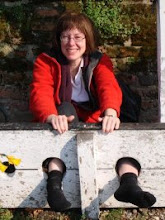Here is an unfinished quilt top - it is very large at 90 x 104 ". Perhaps it just grew and grew, as many tops do, and then was never finished off!
The quilt top is made of applique flowers set with plain blocks. The fabrics are a mixture of prints and plains, and have a perky charm to them.
The cats had a look......
Pink flowers....
Blue flowers...
Purple flowers...
Even green flowers...but all have similar colour pots....
The rather pastel colours remind me of 30's colour schemes - especially that green colour, which at one time was very popular. This quilt top has been made solely by hand - even the long borders are sewn by hand, not by machine. The seller was located outside Edinburgh, and this top came to them with other linen; nothing more is known about it. So it could be British or it could be North American.....there was much cross over, both amongst patterns and also quilters, so it is difficult to be certain where it originally came from. A very jolly sort of pattern!





















